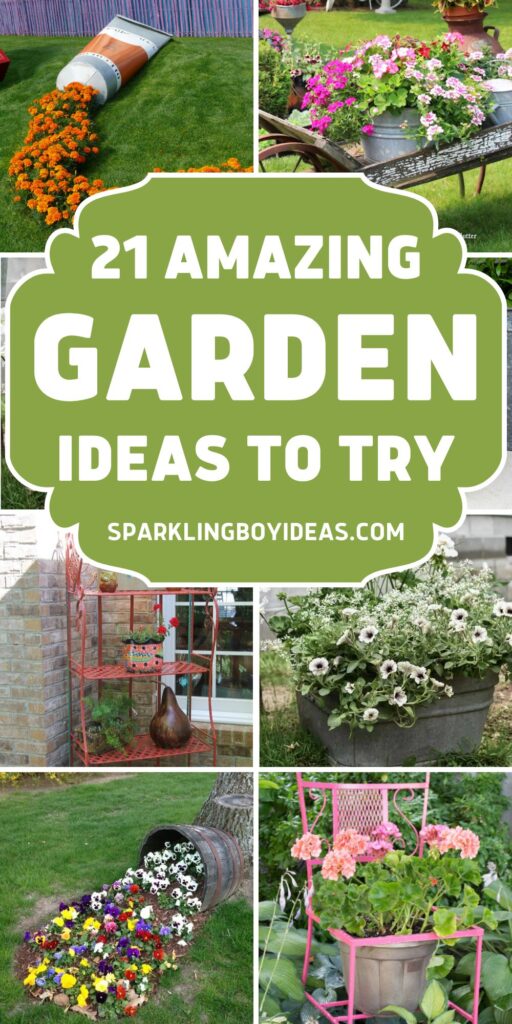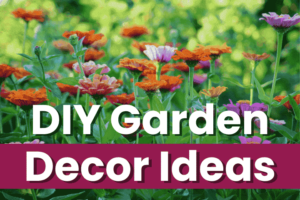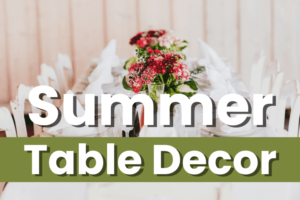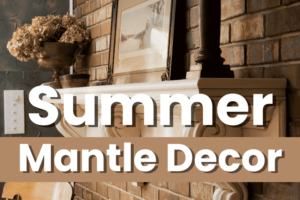Transform your outdoor space with inspiring small garden ideas that suit every style and layout. From tropical garden designs to practical vegetable garden layouts, discover creative solutions for any space. Whether you’re working with a sloped backyard, planning pool landscaping, or enhancing a driveway entrance, these ideas combine functionality and beauty. Explore DIY garden projects, rockery garden ideas, and formal garden layouts to bring your dream garden to life.
Revamp your outdoors with versatile garden ideas that cater to every style and need.
If you’re working with limited space, try rock garden designs or small courtyard layouts to maximize beauty and efficiency.
For larger spaces, explore pool landscaping ideas that blend lush greenery with elegant designs, or add a touch of the tropics with bamboo garden themes.
Sloped yards? Transform them with steep hill landscaping or dry creek bed landscaping ideas to tackle uneven terrain stylishly.
Whether it’s a formal rose garden design or a practical vegetable garden layout, there’s an idea for every garden enthusiast.
Add personal touches with DIY garden projects to make your outdoor space uniquely yours.

“ Affiliate links provided for your convenience, please read my disclosure for more information.”
21. DIY Front Porch Planter
Transform your porch with this charming DIY front porch planter idea!
Using a touch of gold for elegance, this project is a great way to add personality to your outdoor space.
Perfect for flowers, greenery, or even bamboo garden ideas, this planter pairs beautifully with modern or farmhouse landscaping ideas.
It’s an easy, budget-friendly way to refresh your home landscape design and create a welcoming entryway.
Ready to level up your porch? This planter is the way to go!
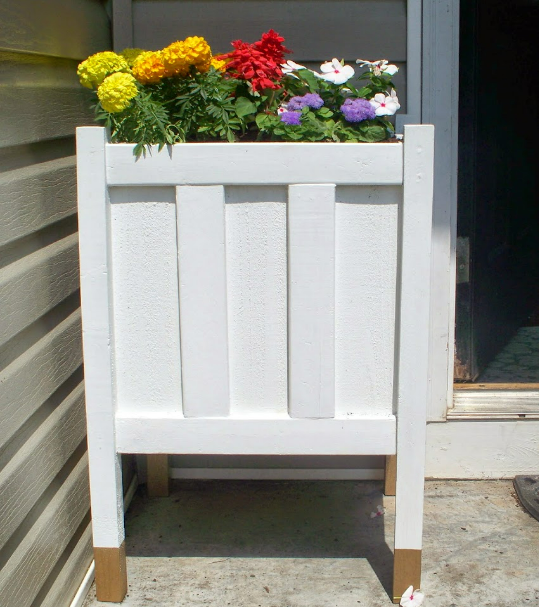
Credit: Home Heart And Hands
20. Upcycled Tire Planter
Who knew an old tire could look this good?
This upcycled tire planter is a fabulous way to combine creativity and sustainability.
Painted and filled with vibrant flowers, it’s perfect for small yards or quirky rock garden ideas for small spaces.
Add this to your list of DIY garden projects for an eco-friendly statement piece that makes your outdoor space pop.
Whether for your front yard or driveway entry landscaping, this planter is a showstopper!

Credit: Addicted 2 DIY
19. DIY Mini Container Water Garden
Bring serenity to your outdoor space with a DIY container water garden.
Ideal for patios or small backyards, this project combines lush greenery with the soothing element of water.
Pair it with bromeliad garden ideas or a formal garden layout to create a calming oasis.
Whether you’re looking for corner lot landscaping ideas or something unique for your balcony, this water garden will surely impress.
It’s easy, elegant, and Instagram-worthy!

Credit: What’s Ur Home Story
18. Spilled Paint Flower Garden
Add some whimsy to your yard with a spilled-painted flower garden!
This playful idea features marigolds “spilling” out of an orange paint tube for a creative twist on traditional gardening.
It’s a perfect conversation starter and works wonderfully with small courtyard designs or coastal garden ideas.
This easy-to-create garden feature brings art and nature together in the most charming way.
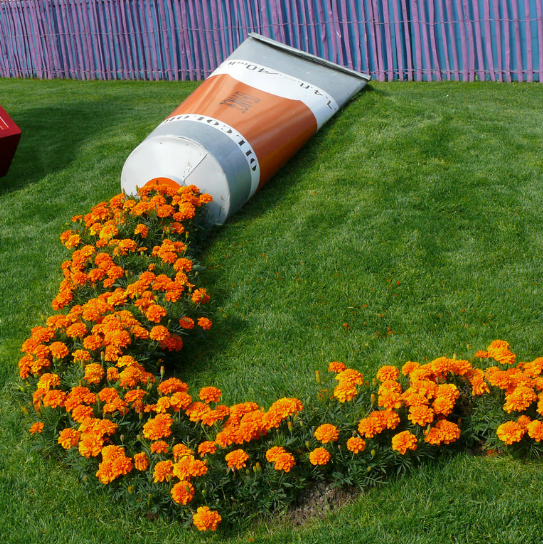
Credit: Creative’s Potting
17. Spilled Flower Pot Display
This spilled flower pot display is the definition of garden magic!
Create the illusion of flowers spilling out of a tipped pot for a fun and eye-catching design.
Use it as part of corner rockery ideas or to enhance your slope backyard design.
It’s a simple yet impactful project that adds charm and creativity to any garden.
Bonus? It’s a perfect fit for small spaces or large yards alike!

Credit: Fresh Patio
16. DIY Succulent Log Planter
Give your garden a rustic touch with a succulent log planter.
Perfect for Asian landscape or formal garden ideas, this natural design blends effortlessly with any outdoor theme.
Hollow out a log, plant succulents, and voila, a stunning centerpiece for your yard!
This planter is an earthy, elegant addition to your space, whether it’s for your porch or dry creek bed landscaping ideas.

Credit: House Of Haw Thornes
15. Bathroom Light Fixture Planter
Who says planters have to be boring?
Turn an old bathroom light fixture into a chic planter for succulents or herbs!
This DIY idea is great for modern or vintage-themed gardens.
Pair it with corner house landscaping ideas or as part of your backyard bridge ideas for a touch of whimsy and creativity.
It’s a functional and stylish way to repurpose old items, perfect for small spaces.

Credit: Birdz Of A Feather
14. DIY Galvanized Tub Planters
Add farmhouse charm to your garden with these galvanized planters.
Perfect for flowers, herbs, or even small trees, they bring a rustic touch to any garden layout.
Use them as part of your driveway design ideas for landscaping or to enhance your formal garden layout.
These planters are versatile, durable, and effortlessly stylish; a must-have for anyone looking to elevate their outdoor space!

Credit: Rocky Hedge Farm
13. Rusty Outdoor Garden Stand Makeover
This rusty outdoor garden stand makeover gives old garden stands a new lease on life!
A little paint and creativity can turn a forgotten piece into a charming focal point for your garden.
Pair it with narrow garden ideas or accent your desert landscaping front yard.
It’s an easy, budget-friendly project that adds character and style to your outdoor space.
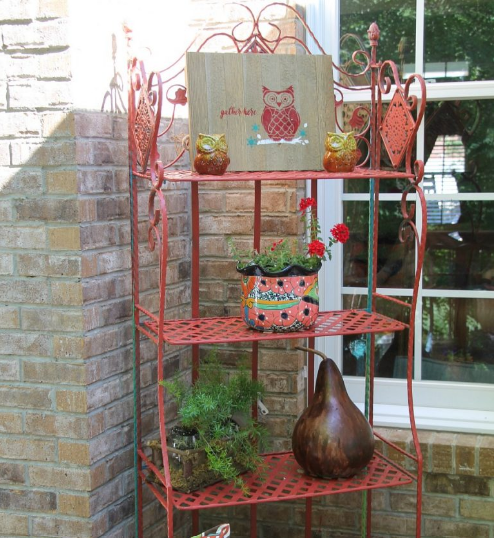
Credit: Debbie Debbie Doos
12. DIY Rubber Boot Planters
Add a splash of fun to your garden with rubber boot planters!
These quirky containers are perfect for flowers, succulents, or herbs and work wonderfully with small vegetable garden layout ideas or rain garden ideas.
Place them along a pathway or use them to liven up your driveway entrance landscaping.
They’re adorable, easy to make, and guaranteed to make your garden stand out!

Credit: House Of Haw Thornes
11. Upcycled Vintage Toy Truck Planter
Bring a touch of nostalgia to your garden with a vintage toy truck planter.
Fill the bed with succulents or vibrant blooms for a playful and unique garden feature.
This idea fits perfectly with corner lot landscaping or as a whimsical accent in a tropical garden design.
Whether you want to personalize your space or add charm to a small area, this planter is a delightful addition!
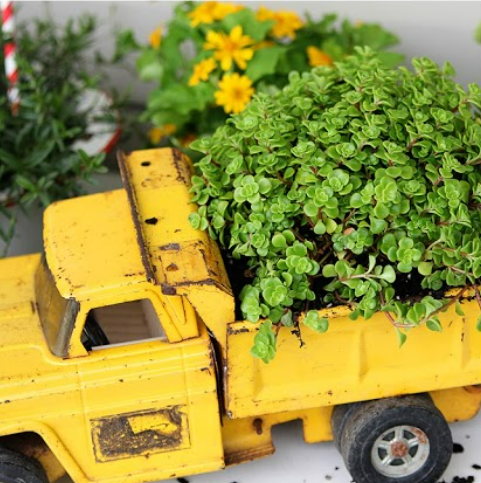
Credit: House Of Haw Thornes
10. DIY Upcycled License Plate Planter
This DIY upcycled license plate planter adds a rustic touch to your garden!
It’s the perfect way to turn old plates into charming garden décor.
Whether creating a unique rockery garden or enhancing your driveway landscape, this project is fun and functional.
Plant colorful blooms or vibrant succulents to make it pop.
It’s a fantastic idea for DIY garden projects that’s easy, affordable, and full of personality.
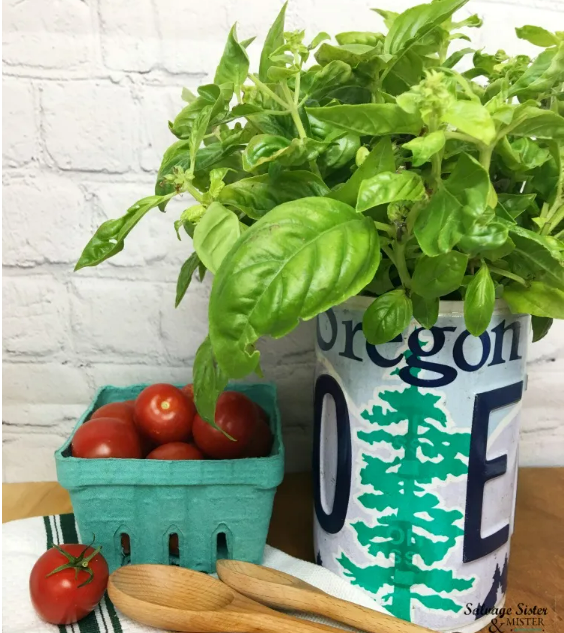
Credit: Salvage Sister And Mister
9. DIY Bird Feeder Using Vintage Snack Set
Transform a vintage snack set into a charming DIY bird feeder that adds elegance to your garden.
This creative project is perfect for enhancing a garden landscape or adding interest to a tropical garden design.
Hang it near your patio or flower beds to attract feathered friends while adding a unique decorative touch.
Perfect for nature lovers and anyone looking for diy yard projects that make a statement!
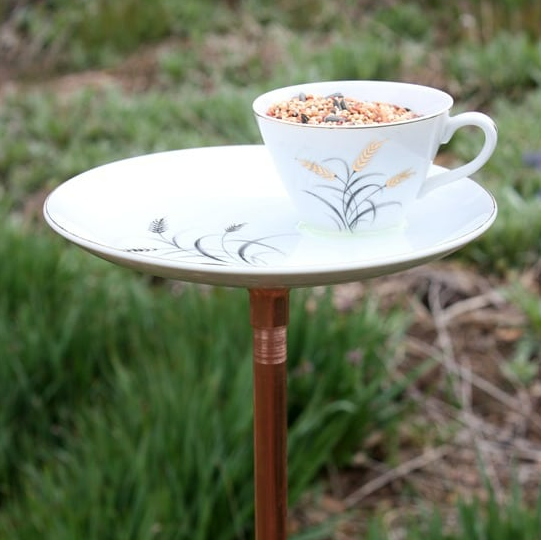
Credit: Virginia’s Sweet Pea
8. Repurposed Seed Spreader Planter
Turn your yard sale treasures into garden gold with these repurposed garden ideas!
From quirky planters to unique yard art, these upcycled pieces are perfect for creating a one-of-a-kind garden theme.
Whether designing a coastal garden or a small courtyard, these ideas will inspire you to add personality and charm to every corner of your outdoor space.
Who knew diy garden projects could be this fun?

Credit: House Of Haw Thornes
7. Planting Pansies On The Deck Junk Garden Style
This creative junk garden idea featuring vibrant pansies brings life to your deck!
This project gives old items a new purpose, perfect for a small vegetable garden layout or a whimsical corner lot landscaping plan.
Use weathered containers or quirky finds to create a garden full of character.
It’s a delightful way to merge gardening with upcycling for a truly unique outdoor space.

Credit: Organized Clutter
6. Pink Repurposed Patio Chair Garden Planters
Turn curbside trash into treasure with these upcycled patio chair planters!
These chic planters are perfect for sprucing up your driveway entrance landscaping or adding flair to a farmhouse landscape design.
Add some potted plants or cascading blooms to create an eye-catching centerpiece.
A great way to practice sustainability while making your DIY garden projects stand out.
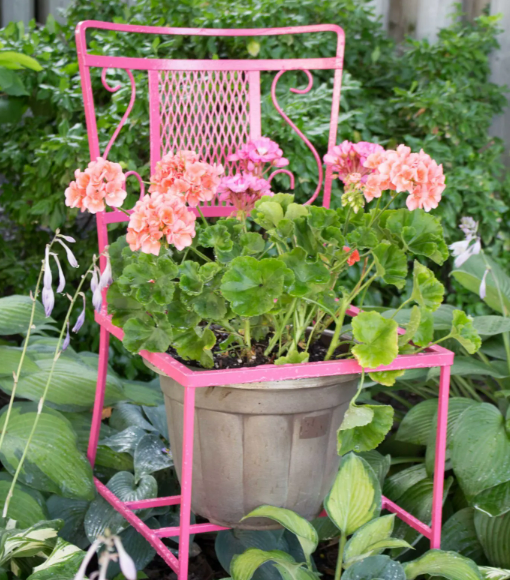
Credit: Sustain My Craft Habit
5. Decorating the Deck with Rustic Birdhouses
Add charm to your deck with these adorable rustic birdhouses!
Perfect for enhancing your backyard pool landscaping or adding interest to sloped front yard landscaping, these birdhouses double as décor and functional homes for birds.
Arrange them on a deck rail or garden table for a cozy, rustic vibe.
It’s an easy way to elevate your outdoor space with a bit of creativity.
Credit: Organized Clutter
4. Rustic Garden Wheelbarrow
Give your garden a vintage touch with a rustic garden wheelbarrow!
Fill it with colorful blooms, greenery, or herbs to create a stunning centerpiece for your sloped backyard landscaping or formal garden layout.
This timeless design brings charm and functionality to your outdoor space, making it a perfect addition to country landscaping ideas or diy yard projects.

Credit: Organized Clutter
3. Beach Themed Fairy Garden
Create a magical escape with a beach-themed fairy garden!
This project combines tiny seaside décor with lush greenery to bring a whimsical touch to any tropical garden design or rock garden ideas for small spaces.
Add miniature seashells, sand, and fairy figurines for an enchanting look perfect for DIY garden projects.
A dreamy way to bring coastal vibes to your outdoor space!
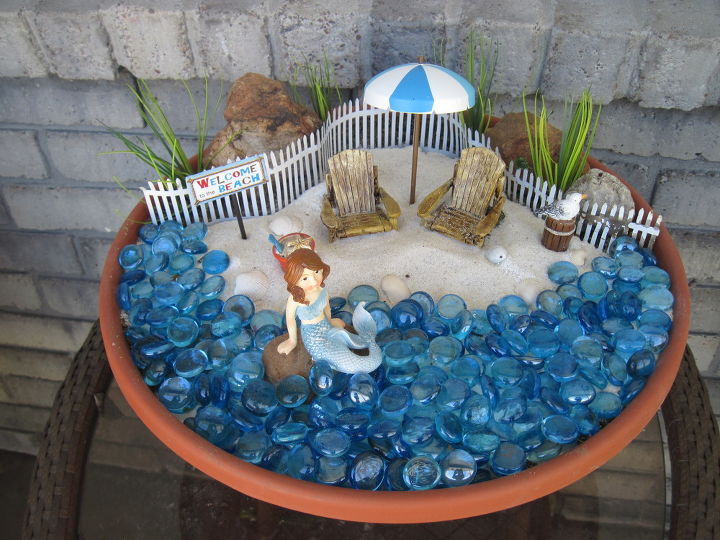
Credit: Hometalk
2. DIY Kid-Friendly Fairy Garden Design
Get the kids involved with this easy and cheap fairy garden design!
Packed with fun and imagination, it’s a perfect project for a narrow garden idea or edible landscaping.
Use mini figurines, colorful plants, and simple materials to create a magical garden that’s playful and charming.
An excellent way to spark creativity while enhancing your outdoor space with adorable diy yard projects.

Credit: The DIY Mommy
1. Beautiful Flowers in Junky Containers
Turn your junky containers into stunning planters with this creative garden idea!
This project gives new life to old objects, perfect for adding character to a bamboo garden or brightening up a desert landscaping front yard.
Fill them with vibrant flowers and arrange them throughout your garden for a rustic yet colorful vibe.
A true testament to how diy garden projects can transform any space!
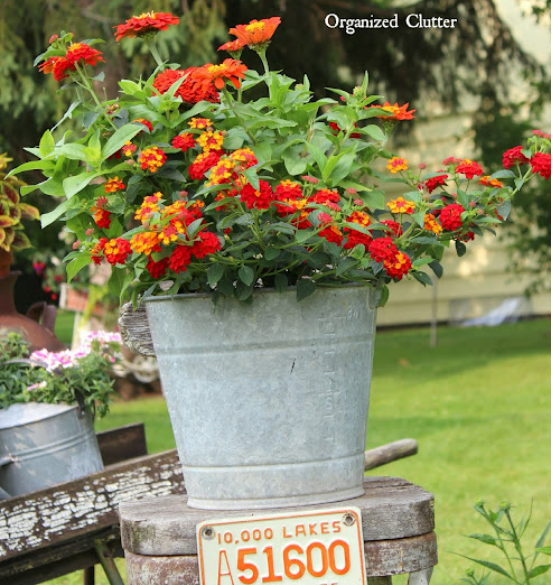
Credit: Organized Clutter
FAQs About DIY Small Garden Ideas On A Budget
Q. What are some creative garden layout ideas for small spaces?
Small spaces can be transformed with rockery garden designs, vertical gardening, and narrow garden ideas. For a functional yet stylish approach, incorporate raised beds, compact vegetable garden layouts, or even a salsa garden layout.
Q. How can I create a tropical garden in my backyard?
To achieve a lush tropical garden design, include exotic plants like palms, bromeliads, and bamboo. Pair them with tropical pool landscaping features, such as a small water fountain or natural stone borders, for an authentic tropical vibe.
Q. What are the best landscaping ideas for sloped yards?
For sloped yards, opt for landscaping slopes with rocks or tiered gardens to prevent soil erosion. Incorporating steep slope landscaping ideas, such as cascading plants and stone pathways, enhances functionality and aesthetic appeal.
Q. How can I design a garden driveway that’s both functional and beautiful?
A garden driveway can blend utility with charm by adding driveway flower bed ideas, borders with perennials, or even a small dry creek bed landscaping along the sides for a rustic touch.
Q. What are the benefits of incorporating edible landscaping into garden ideas?
Edible landscaping ideas combine beauty and utility by integrating vegetables, fruits, and herbs into garden designs. Salsa garden layouts or an edible flower bed can add color and functionality to your garden.
Now comes the important question… Which garden ideas do you like the most? Please let me know in the comments.
Want to save this for later? Post these Garden Ideas to the “Garden Inspirations” OR “DIY Garden Ideas” Board!
